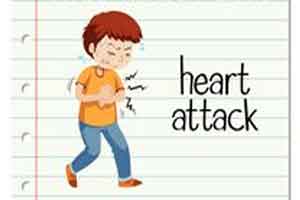- Home
- Editorial
- News
- Practice Guidelines
- Anesthesiology Guidelines
- Cancer Guidelines
- Cardiac Sciences Guidelines
- Critical Care Guidelines
- Dentistry Guidelines
- Dermatology Guidelines
- Diabetes and Endo Guidelines
- Diagnostics Guidelines
- ENT Guidelines
- Featured Practice Guidelines
- Gastroenterology Guidelines
- Geriatrics Guidelines
- Medicine Guidelines
- Nephrology Guidelines
- Neurosciences Guidelines
- Obs and Gynae Guidelines
- Ophthalmology Guidelines
- Orthopaedics Guidelines
- Paediatrics Guidelines
- Psychiatry Guidelines
- Pulmonology Guidelines
- Radiology Guidelines
- Surgery Guidelines
- Urology Guidelines
Elevated cardiac troponin may occur without heart attack: Latest JACC Study

Elevated cardiac troponin, a diagnostic marker of damage to the heart, may occur even if a patient has not had a heart attack, according to a study published in JACC: Basic to Translational Science.
In a porcine model of brief ischemia leading to reversible stunning in the absence of myocardial tissue necrosis, Brian R. Weil, PhD, and colleagues demonstrated delayed release of cardiac troponin I that exceeded the 99th percentile for normal animals 60 minutes after reperfusion and rose to readily detectable levels 24 hours later. Although tissue analysis at 60 minutes showed no evidence of necrotic myocyte cell death seen with a myocardial infarction, TUNEL (terminal deoxynucleotidyl transferase-mediated dUTP nick-end labeling) staining demonstrated isolated myocytes undergoing apoptosis, which was absent after 24 hours. These results demonstrate that cardiac troponin I elevations occur after cardiac injury that is not severe enough to produce classic myocyte necrosis that is observed following heart attack and that elevated troponin levels may reflect myocyte injury in the absence of pathological evidence of infarction.
"This study by Weil and colleagues, although performed in a large animal model, may have important implications for health care systems, which are currently overwhelmed with trying to understand how to choose the appropriate diagnostic codes for hospitalized patients who have elevated troponin levels, which are being detected with alarming regularity following the FDA approval of new 'high sensitivity' troponin assays," said Douglas L. Mann, MD, FACC, editor-in-chief of JACC: Basic to Translational Science. "A rise in troponin has traditionally been associated with an acute myocardial infarction. Accordingly, when a patient has an elevated troponin level, they are often subjected to a battery of expensive non-invasive and invasive testing in order to be certain that the patient is not at risk of dying from a 'heart attack.'
"This study by Weil and colleagues clearly shows that troponin elevations can occur in the absence of a classic myocardial infarction, but can occur from a different form of cell death, called apoptosis. Although the study may not immediately stop the unnecessary testing that follows the incidental detection of an elevated troponin level, it should focus future research efforts on understanding how and why troponin is released from the heart, so that we have a better understanding of what to say to patients when they have an elevated troponin level detected on a routine laboratory test."

Disclaimer: This site is primarily intended for healthcare professionals. Any content/information on this website does not replace the advice of medical and/or health professionals and should not be construed as medical/diagnostic advice/endorsement or prescription. Use of this site is subject to our terms of use, privacy policy, advertisement policy. © 2020 Minerva Medical Treatment Pvt Ltd